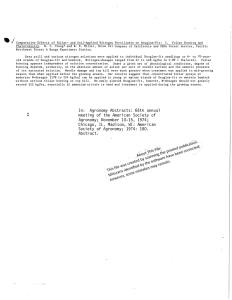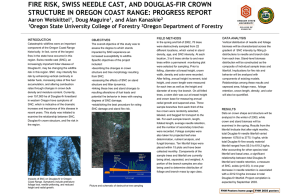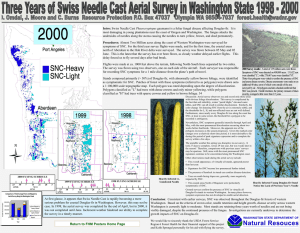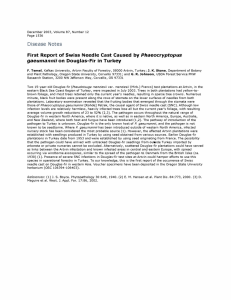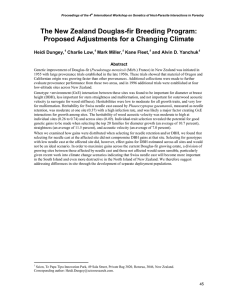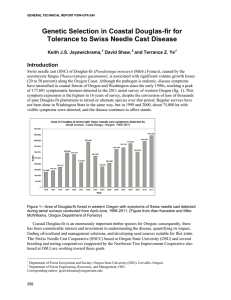Relationships between Swiss needle cast and ectomycorrhizal fungus diversity
advertisement
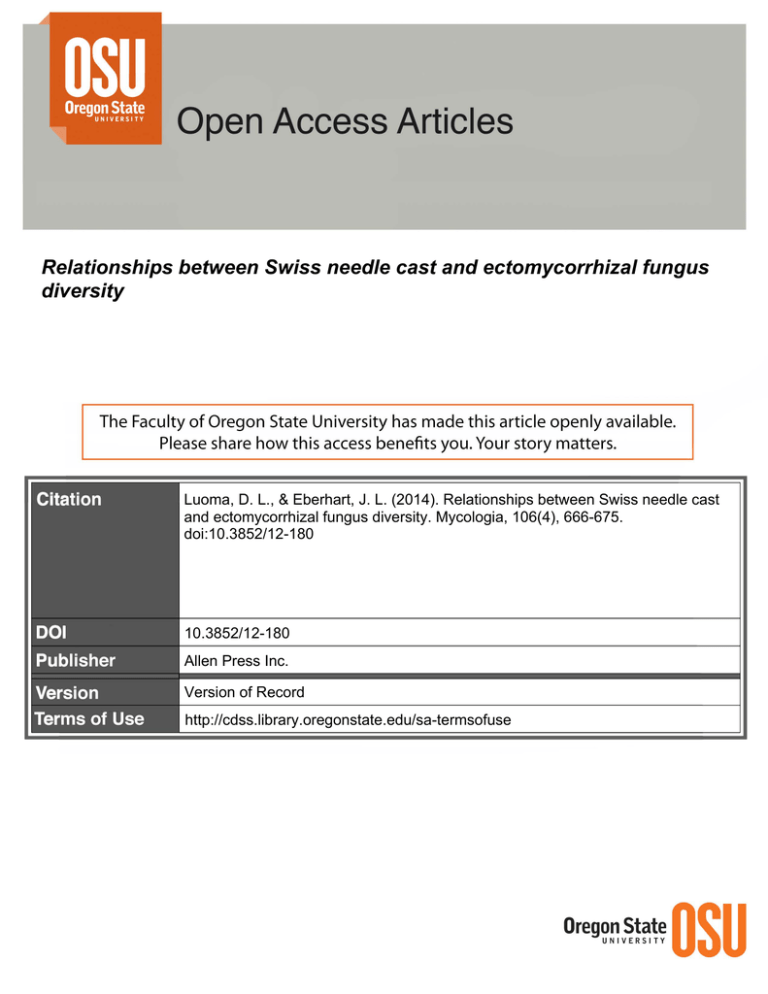
Relationships between Swiss needle cast and ectomycorrhizal fungus diversity Luoma, D. L., & Eberhart, J. L. (2014). Relationships between Swiss needle cast and ectomycorrhizal fungus diversity. Mycologia, 106(4), 666-675. doi:10.3852/12-180 10.3852/12-180 Allen Press Inc. Version of Record http://cdss.library.oregonstate.edu/sa-termsofuse Mycologia, 106(4), 2014, pp. 666–675. DOI: 10.3852/12-180 # 2014 by The Mycological Society of America, Lawrence, KS 66044-8897 Relationships between Swiss needle cast and ectomycorrhizal fungus diversity Daniel L. Luoma1 Joyce L. Eberhart and elsewhere via import of live Douglas-fir seedlings (Stone et al. 2007). It was the initial discovery of the disease in Douglas-fir plantations in Switzerland in the mid-1920s that engendered the name of the disease (Gaümann 1930). Until the mid-1980s, P. gaeumannii was considered an unimportant and minor pathogen (Boyce 1940, Hansen et al. 2000). Under most conditions, P. gaeumannii is a benign component of the tree canopy and does not contribute to premature needle shed or growth loss. Nevertheless, since the late 1980s and early 1990s SNC has caused an epidemic affecting hundreds of thousands of acres, across a wide variety of soil conditions, in the western Oregon Coast Range from Coos Bay to Astoria. Annual aerial surveys conducted by the Oregon Department of Forestry have shown a consistent increase in affected areas since the surveys began in 1996. The 2011 aerial survey mapped more than 160 000 ha with symptoms of SNC. Most diseased trees occurred within 29 km of the Pacific Ocean, but SNC symptoms extended up to 40 km inland (Kanaskie and McWilliams 2011). Stone et al. (2008) note the strong correlation of P. gaeumannii abundance and disease severity with climatic factors, particularly winter mean temperature. Growth losses in the area of epidemic infection generally are 20–50%, and annual growth losses are estimated to exceed $200 000 000 per year (Maguire et al. 2002). It is important to consider the potential links between ectomycorrhizal (EM) fungi and SNC. Ectomycorrhizal fungi are essential for host plant nutrient uptake and play important roles in nutrient cycling in many forests (Cromack et al. 1979, Smith and Read 2008). For example, an estimated 50–70% of the net annual productivity may be translocated to roots and associated mycorrhizal fungi (Fogel and Hunt 1979, Vogt et al. 1982, Norton et al. 1990). Markkola et al. (2004) found reduced carbon allocation to roots after 100% defoliation and that fungal biomass in fine roots decreased when defoliation occurred in the year of harvest but not when the defoliation was conducted the previous year. They concluded that current photosynthates are particularly important for EM fungal symbionts. Most of the dominant and economically important timber species in the Pacific Northwest are EMdependent, including all members of the pine, oak and birch plant families (Smith and Read 2008). Douglas-fir alone is thought to have about 2000 EM fungal symbionts throughout its range (Trappe 1977) and appears unable to grow in soil without ectomycorrhizal fungi (Trappe and Strand 1969). Department of Forest Ecosystems and Society, Oregon State University, Corvallis, Oregon 97331 Abstract: Swiss needle cast (SNC) is a disease specific to Douglas-fir (Pseudotsuga menziesii) caused by the ascomycete Phaeocryptopus gaeumannii. Here we examine characteristics of the EM fungus community that are potentially useful in predictive models that would monitor forest health. We found that mean EM density (number of colonized root tips/soil core) varied nearly 10-fold among sites of varying levels of SNC, while mean EM fungus species richness (number of species/soil core) varied by about 2.5 times. Strong relationships were found between EM and SNC parameters: EM species richness was positively correlated with both Douglas-fir needle retention (R 2 5 0.93) and EM density (R 2 5 0.65); EM density also was significantly correlated with Douglas-fir needle retention (R 2 5 0.70). These simple characteristics of the EM fungus community could be used to monitor forest health and generate predictive models of site suitability for Douglas-fir. Based on previous findings that normally common EM types were reduced in frequency on sites with severe SNC, we also hypothesized that some EM fungi would be stress tolerantdominant species. Instead, we found that various fungi were able to form EM with the stressed trees, but none were consistently dominant across samples in the severely diseased areas. Key words: anthropogenic disturbance, climate change, ecosystem health, Phaeocryptopus gaeumannii INTRODUCTION Swiss needle cast (SNC) disease is specific to Pseudotsuga menziesii (Mirb.) Franco (Douglas-fir) and is caused by the ascomycete Phaeocryptopus gaeumannii (T. Rohde) Petr. (Gaümann 1930 in Stone et al. 2008). SNC affects the foliage of Douglas-fir: symptoms include chlorotic needles and premature needle abscission, resulting in reduced leaf area index and vigor (Manter et al. 2000, McGuire et al. 2002, Weiskittel and McGuire 2007). Phaeocryptopus gaeumannii is native to the western United States and presumably was introduced in Europe, New Zealand Submitted 15 May 2012; accepted for publication 2 Jan 2014. 1 Corresponding author. E-mail: luomad@fsl.orst.edu 666 LUOMA AND EBERHART: ECTOMYCORRHIZAE AND SWISS NEEDLE CAST In a 2006 pilot study we found that Douglas-fir forests with moderate to high SNC (as measured by foliage retention) had 3–4 times fewer EM fungus species than similar Douglas-fir stands without appreciable SNC (Eberhart et al. 1996, Luoma et al. 2006) and had numbers of EM species comparable to that of sites that had experienced significant disturbance from clear-cutting and fire (Luoma and Eberhart 2006). We concluded that the degree of EM fungus diversity detected in the pilot study suggested that the belowground ecosystem was being strongly affected by SNC, alone or in combination with the previous removal of mature trees during timber harvest and postharvest silvicultural practices. Here we present work that was undertaken to provide better understanding of relationships between EM fungus diversity and SNC in northwestern Oregon. We assumed the EM fungus community structure varied substantially across the landscapes in which SNC is found for many potential reasons, particularly those tied to variations in climate and soil conditions. We hypothesized that in comparing sites of similar age, structure and management history across a gradient of SNC disease, EM root-tip density and EM fungus species richness (at the scale of the soil core) would be inversely correlated with SNC severity (mean needle age cohorts, measured in years) due to reduced photosynthetic capacity accompanying increasing disease. In addition, preliminary data suggested that some EM fungi were tolerated stress (sensu Grime 1979) because common Douglas-fir EM types formed by genera such as Cenococcum and Rhizopogon were less widespread in SNC-stressed stands than in other studies (Eberhart et al. 1996, Luoma et al. 2006). Because the diseased trees were mycorrhizal, albeit at low EM root-tip densities, we hypothesized that certain EM fungi (with important functional roles to keep Douglas-fir alive in the face of heavy SNC) may become more dominant on the roots that remain. Therefore we examined a second hypothesis that particular stresstolerant EM fungi would be found as dominant members of the EM community. Specifically we hypothesized that (i) common mycorrhiza types of non-SNC affected trees, as measured by mean number of root-tips/soil core, will be less common on high SNC sites; (ii) A limited number of stress-tolerent fungi, possibly adapted to a reduced carbon supply, will be relatively more common, as measured by mean number of EM root-tips/soil core, on high SNC sites. 667 FIG. 1. Study site locations with reference to the Picea sitchensis (Sitka spruce) zone (light gray) in northwestern Oregon. The Tsuga heterophylla (western hemlock) zone, typically dominated by long-lived stands of Douglas-fir, is depicted in dark gray (after Franklin and Dyrness 1973). (Key in TABLE I.) Base map: Oregon Gap Analysis/Oregon Department of Forestry. MATERIALS AND METHODS measured by use of a needle retention index (Hansen et al. 2000). Stands were similarly managed, un-thinned and unfertilized Douglas-fir plantations that were about 20–25 y old at the time of sampling. Additional site information can be found in Stone et al. (2005), Mainwaring et al. (2007) and Mulvey et al. (2013). Foliage retention (mean needle age cohorts, measured in years) has been found to work well for predicting tree and stand growth (Maguire et al. 2002, 2011). Study trees had been mapped and numbered by other researchers (Stone et al. 2005, Mainwaring et al. 2007, Mulvey et al. 2013). EM roots of Douglas-fir were obtained from 350 cc soil cores, 15 cm 3 5.5 cm. At each site one soil core was taken from beneath the canopy of each of 10 trees chosen randomly from the list of prenumbered trees. Soil cores were located approximately 1 m from the base of each tree and on the side of the bole closest to the nearest neighboring Douglas-fir, so as to bias for maximum Douglas-fir root density. A total of 70 soil cores were obtained (10 trees/site 3 7 sites) in Feb 2007. We also sampled two sites in 2008 that included the most severely diseased site, GDH, as well as another heavily affected site (Swede Hill) near GDH (TABLE I). Field sites.—The study sites (FIG. 1) varied by degree of SNC disease symptoms (TABLE I), and disease severity was Laboratory.—Soil cores were kept cool in the field and stored at 220 C immediately after returning from the field. Stems 5 mean number of Douglas-fir trees per ha. SNC index 5 mean years needle retention (n 5 10). 3 EM density 5 mean number of live ectomycorrhizal root-tips per 350 cc soil core (n 5 10). Non-EM tips were almost nonexistent (, 1 in 10 000). 4 For the 2007 dataset, means across locations not sharing letters are significantly different at P # 0.05, standard errors are in parentheses. In 2008 the response variables did not differ (n 5 10). 5 EM richness 5 mean number of EM types per 350 cc soil core (n 5 10). 6 The Green Diamond ‘‘Swede Hill’’ site was in essentially the same location as the GDH site at the scale of the map. 2 1 (0.76) (0.74) (0.76) (0.65) (0.60) (0.48) (0.67) (0.37) (0.45) 7.7d 5.9cd 4.6bc 4.3abc 3.3ab 2.9ab 2.9a 2.5 2.3 (106.6) (60.0) (42.4) (105.0) (27.5) (92.9) (20.0) (21.5) (35.9) 478.6e 274.9d 149.9abc 274.9cd 99.3ab 236.6bcd 65.8a 122.1 123.5 3.62 3.12 2.94 2.99 2.31 2.17 1.70 1.70 1.59 921 977 754 819 877 683 724 724 430 2007 2007 2007 2007 2007 2007 2007 2008 2008 Pleasant Hill Waterloo Burnt Woods McDonald Forest Elk City Grand Ronde Hemlock Hemlock Swede Hill Giustina Land & Timber Cascade Timber Consulting Starker Forests Oregon State University Oregon Dept. of Forestry Hampton Affiliates Green Diamond Resource Green Diamond Resource Green Diamond Resource GPH CTC STR OSU ODF HGR GDH GDH GDH6 Location Map code Year Stems1 SNC index2 EM density3,4 Richness4,5 MYCOLOGIA Land manager at time of study TABLE I. Study sites with map codes (FIG. 1), year of sample, Douglas-fir density, disease severity index, variation in EM density and variation in EM fungus species richness among study sites 668 When soil cores were thawed they were examined within 48 h. Roots were extracted from the soil cores by wet sievewashing over a 1 mm grate. The contents of the sieve were spread evenly, with sufficient water to cover, in the bottom of a 38 3 17 3 2 cm tray that was divided into 36 compartments by an inserted Plexiglas partition (Eberhart et al. 1996). Roots were examined with a stereomicroscope at 15–303 magnification. Each EM type encountered was classified by morphological characteristics similar to those described in Ingleby et al. (1990) and Goodman et al. (1996) including color, texture, presence/absence of rhizomorphs and emanating hyphae. Morphotype identities were determined by comparison to the EM character database maintained by J. Eberhart (unpubl), some of which had been determined to genus or species by DNA sequencing (Luoma and Eberhart 2006). The total number of EM types per soil core and total number of mycorrhizal root tips in each core were recorded for 10 soil cores from seven sites in 2007 and two sites in 2008. Representative samples (a minimum of two tips each) of the predominant mycorrhiza types were saved in CTAB buffer for molecular analysis of the fungal DNA. Molecular analysis.—For the most common EM morphotypes in the 2008 samples, we extracted DNA following the method described by Avis et al. (2003) with a plant DNA extraction kit (REDExtract-N-Amp Plant PCR Kit, Sigma, St Louis, Missouri). The ITS region (ITS1, 5?8S and ITS2) of the rRNA operon was amplified with primer set ITS1-F/ ITS4 (White et al. 1990, Gardes and Bruns 1993). PCR was performed with the REDExtract-N-Amp Plant PCR Kit with PCR cycling conditions modified from Gardes and Bruns (1993). Cycling conditions included an initial denaturation at 94 C for 3 min followed by 35 PCR cycles (93 C, 35 s; 55 C, 53 s; 72 C, 30 + 05 s per cycle) and 72 C for 10 min. Amplified ITS products were visualized in 2% agarose gels stained with ethidium bromide under UV illumination. For sequencing, samples producing a single PCR product were purified before sequencing with ExoSAP-IT (USB, Cleveland, Ohio). Sequencing was performed by the Center for Genome Research and Biocomputing Core Laboratory at Oregon State University with an ABI Prism 3730 genetic analyser (Applied Biosystems, Foster City, California) with the forward primer ITS1F. Sequences were identified by querying the GenBank database with the nucleotidenucleotide (BLASTN) query option on the National Center for Biotechnology Information website (Altschul et al. 1997). We set a functional species match criterion at 98% sequence similarity over at least 500 bp with vouchered sporocarp sequences, although not all matches at that level of similarity had corresponding species determination. Taxon assignment of EM fungi to our morphotypes was made with the BLASTN results. These were added to the EM morphotype identities in the EM character database maintained by J. Eberhart. Our manually trimmed sequences were submitted to GenBank (TABLE II). Statistical analysis.—Number of EM types per soil core (species richness) and total number of EM tips per soil core (feeder root density) were used as response variables. The data were used to test for gradient responses to SNC disease. KC618522 KC618512 KC618510 99 97–98 98 99 94 100 99 96 96 99 99 95–96 99 99 99 KC618525 KC618514 KC618515 KC618523, KC618513, KC618521 KC618507 KC618517 KC618509, KC618524 KC618520 KC618519 KC618516 KC618518, KC618511, KC618526 KC618508 R3472 R3432 R3428 R3486 R3434 R3445 R3482, R3433, R3461 R3421 R3452 R3426, R3483 R3460 R3457 R3450 R3454, R3431, R3487 R3423 5 10 15 5 5 5 20 5 5 5 5 10 10 5 5 Amanita cf. gemmata Amphinema sp. Clavulina cristata Clavulinaceae Hydnotrya sp. Inocybe sp. Lactarius luculentus Melanogaster sp. Pseudotomentella Russula nigricans Sebacinaceae Thelephoraceae Tomentella sp. Tomentella sublilacina Tylospora asterophora sp. 7 9 197 28 36 8 170 11 113 125 3 226 109 39 33 Maximum identity (%) GenBank accession No. Sample ID No. Constancy (%) No. of tips colonized 669 ANOVA was used for comparisons across the sites. When appropriate, Fisher’s protected least significant difference test was used to determine whether study site means differed from one another. Linear regression was used to examine gradient responses in EM density and EM fungus species richness to among-block variation in SNC severity (foliage retention). Linear regression also was used to measure the association between EM density and EM fungus type (species) richness. To address the second hypothesis, we examined the mean number of EM root-tips/soil core and constancy of EM types across soil cores on high SNC sites from the 2008 dataset. When necessary to meet the assumptions of normality and constant variance (Sabin and Stafford 1990), we transformed the dependent variables; EM density was square-root transformed, EM fungus richness was log-transformed. Analyses were carried out with StatView 5.1 software (SAS Institute 1999). RESULTS Taxon TABLE II. Morphotypes identified to lowest taxonomic level from EM collected at the Green Diamond sites in 2008 and sequenced for this study (ITS, 5.8S) including constancy (% of cores out of 20 with taxon present), number of root tips colonized, root-tip sample identification number, GenBank accession number, and maximum identity percentage of the best GenBank match used as the basis of the taxonomic assignment of the EM LUOMA AND EBERHART: ECTOMYCORRHIZAE AND SWISS NEEDLE CAST Fewer than 1 in 10 000 root tips were non-EM. Mean EM root density varied by nearly 10-fold among sites (TABLE I), while mean EM type (species) richness varied by about 2.5 times (TABLE I) in 2007. In the 2008 sample, these response variables were nearly identical for richness and root density (TABLE I) at the GDH and GDS sites; therefore the GDS data were not included in the regressions. Treating mean logEM richness as a dependent variable of mean EM density produced a regression model of: Y 5 0.417 + 0.001 * X; R 2 5 0.65, P 5 0.03 (FIG. 2). Mean squareroot EM density treated as dependent on mean years needle retention produced a regression model of Y 5 21.583 + 5.932 * X; R 2 5 0.70, P 5 0.02 (FIG. 3). For the main 2007 sample, mean log EM richness treated as dependent on mean years needle retention produced a regression model of Y 5 0.002 + 0.232 * X; R 2 5 0.90, P 5 0.001 (FIG. 4). When data from the 2008 sample of the GDH site were added to that model, the EM richness vs. years needle retention model improved to Y 5 0.023 + 0.226 * X; R 2 5 0.92, P 5 0.0001 (FIG. 4). From the 20 soil cores examined in the 2008 Green Diamond sample, a total of 31 EM types were identified by morphotyping and molecular methods. Fifteen of the 31 types were assigned to taxa with ITS sequencing (TABLE II). Twenty-four of the 31 EM types found at the Green Diamond site were recorded from one soil core each. An additional four EM types were recorded from only two soil cores each. Only one EM type (Cenococcum geophilum) was regularly represented in the Green Diamond soil cores with 40% constancy (8 of 20 cores). The Lactarius luculentus morphotype was found in four soil cores and was confirmed by ITS sequencing of samples from two soil cores. The L. luculentus type matched 670 MYCOLOGIA FIG. 2. Regression plot of mean EM type (species) richness (log transformed) against mean root density (R 2 5 0.65, P 5 0.03, per site n 5 10). (100% similarity) within each core and between the cores. Two EM types that were tentatively assigned to the L. luculentus type based on morphology later were found to be different taxa when sequenced (Tylospora sp. and Hydnotrya sp.). Among EM morphotypes found in two different cores each, matches to their own types in the other core were at least 98% similar for four of the types. Two distinct single-core EM morphotypes matched at the family level (83–88%) between two soil cores. The eight FIG. 3. Regression plot of mean EM root density (square-root transformed) against mean years needle retention (R 2 5 0.70, P 5 0.02, per site n 5 10). LUOMA AND EBERHART: ECTOMYCORRHIZAE AND SWISS NEEDLE CAST 671 FIG. 4. Regression plot of mean EM type (species) richness (log transformed) against mean years needle retention (R 2 5 0.93, P 5 0.0001, per site n 5 10). Open circle represents the 2008 resample of the GDH site. other single-occurrence EM morphotypes were distinct and did not match the other types, even at the family level based on the ITS sequences. Those results (13/15) produced a success rate of 87% at correctly discerning species-level morphotypes. DISCUSSION The hypothesis that EM density and species richness are correlated with SNC severity was supported. Across a gradient of SNC disease (as measured by mean years of needle retention), EM root-tip density and EM fungus species richness varied by factors of nearly 10 and 2.5 respectively. That EM fungus species richness was highly correlated with EM root-tip density is not surprising in that the root tips represent available habitat for EM fungi. The reductions in EM characteristics that we measured did not reveal threshold responses (FIGS. 2–4) to the amount of needle loss. Maguire et al. (2011) studied growth reductions in Douglas-fir stands across a gradient of SNC disease and similarly did not find threshold responses to needle loss. Their model predicts a growth loss of approximately 35% on our most severely diseased site (Green Diamond). The 2007 data demonstrated a strong correlation between EM species richness and Douglas-fir needle retention (R 2 5 0.90). Addition of the 2008 GDH data was made to test the scope of inference of the model over time, especially at severely diseased sites. This allowed for the possibility that the model would show more variance. However, the results strengthened that correlation (FIG. 4) and the R 2 value increased to 0.93, which increases our confidence in the robustness of our model. In severely diseased SNC areas, the low values of EM root density that we observed were less strongly correlated with needle retention than was EM species richness. Even though 2008 root density was twice that observed in 2007 on the Green Diamond Hemlock site (but still low), species richness in 2008 was slightly lower. The 31 EM types (species) obtained from 20 soil cores contrasts with an expected number of 60–65 species found in 20 soil cores (of the same volume) from mature Douglas-fir stands in the Cascade Range not affected by SNC (Luoma et al. 2006 and unpubl data). Despite much reduced EM fungus species richness on severely diseased SNC sites, we found that the proportion of the Douglas-fir root tips colonized by EM fungi remained at almost 100%. These results agree with the findings of Saikkonen et al. (1999), Cullings et al. (2005), and Kuikka et al. (2003), all of whom noted little response of EM colonization (proportion of root tips colonized) to defoliation. Our results also support the theoretical model proposed by Gange (2007) in which he predicted that mycorrhizal species richness would decline in the face of moderate to severe defoliation. 672 MYCOLOGIA Our second hypothesis was that some EM fungus species could be more tolerant of a reduced carbon supply and therefore exhibit increased relative abundance in severely diseased SNC sites. However our results did not support this conclusion. Instead, various fungi were able to form EM with the stressed trees, with none consistently dominant across samples in the most severely diseased areas: the majority of distinct EM types (24 of 31) were found in only one core, and an additional four EM types were found in only two cores each. Thus no single EM type was dominant; only the Cenococcum geophyllum type was regularly represented in the soil cores (40% constancy, 8/20 cores). Cenococcum geophyllum (likely a species complex [Douhan et al. 2007]) is ubiquitous in PNW forests dominated by ectomycorrhizal trees. The next most common EM type was identified from its ITS sequence as Lactarius luculentus and was found with only 20% constancy (4/20 soil cores). Neither of these EM types is considered a candidate for our concept of a stress-tolerant species (sensu Grime 1979) that would dominate a SNC site (i.e. a combination of relatively high constancy across cores and mean root-tip abundance within cores). The Cenococcum type has been reported as occurring with 97–100% constancy in soil cores from our region (Kolaczkowski 2005, Luoma et al. 2006) but its presence on severely diseased trees in this study is greatly reduced from that found in healthy Douglas-fir forests. An alternative to the second hypothesis is that these results are consistent with a ‘‘survival of the survivors’’ scenario. We propose that, while the diversity of EM fungi decreases as SNC disease progresses, particular survivors (albeit not dominant) may reflect patterns of reverse establishment (i.e. community disassembly). With this hypothesis, the remaining EM species supporting Douglas-fir growth on these sites are able to persist simply due to variation in tolerance to SNCcaused decline (e.g. reduced carbohydrates) and the ability of EM fungi to (re-)colonize roots of trees affected by SNC. When compared to stands with little or no SNC, aggregate species richness (approximately a 50% reduction; data not shown) was not affected as severely as local, soil-core species richness (70–80% reduction, TABLE I and Luoma et al. 2006). Avis et al. (2008) note that variables such as species richness may demonstrate different responses to treatments in a soil core when contrasted with responses at a stand. The highly patchy soil environment may provide opportunities for particular EM species to persist due to each species’ unique adaptive advantages in a given location. For instance, Cenococcum was able to maintain a well distributed presence across soil cores in the severely diseased stands but it was not dominant, in terms of constancy or abundance, to the extent that would be expected in healthy stands. Although particular EM fungi did not become dominant, we did find some distinctive responses of EM fungi to SNC. Defoliation, presumably due to SNC, was strongly associated with a reduction in mycorrhizae of Cenococcum geophilum (8/20 cores), Rhizopogon villosulus (two cores), Lactarius rubrilacteus (zero cores), Rhizopogon vinicolor (zero cores), and R. vesiculosis (zero cores). These species have been found to be common EM associates of Douglasfir in other studies (Luoma et al. 2006, Beiler et al. 2010). It is of interest to note that these species are thick-mantled EM types and their reduction in defoliated systems is similar to findings of Markkola et al. (2004) who noted that the most marked decline in thick-mantled mycorrhizae occurred with repeatedly defoliated seedlings. They concluded that carbon limitation strongly influenced EM fungus composition but not percentage of root tips colonized, which was maintained at about 97% (Markkola et al. 2004), similar to our study. Cullings et al. (2005) also noted that a Cenococcum sp. was significantly reduced (in sequence-based assessments of soil samples) by artificial defoliation of pine. In addition to reduced carbon allocation to roots after 100% defoliation, Markkola et al. (2004) found that fungal biomass in the fine roots decreased when 100% defoliation occurred in the year of harvest but not when the defoliation was conducted the previous year. They concluded that current photosynthates are particularly important for EM fungal symbionts. Although not examined in our study, the initial response of EM fungi to reduced photosynthate might be a reduction in reproductive capacity. In an experiment to simulate pine sawfly (Neodiprion sertifer) herbivory, Kuikka et al. (2003) removed all 1 y old needles of Pinus sylvestris in each of two successive years and found that EM fungi reduced investment in reproduction (sporocarp production) in response to the short-term defoliation. Sporocarp biomass and species richness also were negatively affected by the defoliation (2300% and 2100% respectively). They concluded that EM fungus symbionts were able to allocate proportionally less carbon to sexual reproduction due to resource limitation in the host. As with our findings, average mycorrhizal colonization percentage was high (93.5%) and did not differ between the defoliated and control treatments (Kuikka et al. 2003). A finding of a meta analysis by Barto and Rillig (2010) was that defoliation had little or no effect on EM root colonization percentage (although root density was not examined). Carbon limitation and forest succession.—Picea sitchensis (Sitka spruce) is a long-lived but seral dominant LUOMA AND EBERHART: ECTOMYCORRHIZAE AND SWISS NEEDLE CAST that generally outperforms Douglas-fir in the Picea sitchensis zone (Franklin and Dyrness 1973). The zone is typified by a wet and mild climate with minimal summer drought that is further ameliorated by frequent fog and low clouds. Tsuga herterophylla and Thuja plicata also are important tree species within this zone (Franklin and Dyrness 1973). The SNC epidemic area has substantial overlaps with the area covered by the Picea sitchensis zone (Stone et al. 2008, FIG. 1). Growth analyses of competing tree species by Kunstler et al. (2012) have identified leaf mass per unit area as an important functional trait related to species’ niche similarity and competitive ability. The chronic infection of Douglas-fir needles with high P. gaeumannii has reduced growth of young Douglas-fir trees in the Sitka spruce zone, thereby providing a competitive advantage to spruce and hemlock during forest succession (Stone et al. 2008). The distribution of Douglas-fir in lower elevations of the western Oregon Coast Range was sporadic before initiation of commercial logging and conversion of large areas to plantation forestry. This led Stone et al. (2008) to conclude that the Sitka spruce zone exists in part as a result of Douglas-fir growing poorly due to Swiss needle cast disease. Stone et al. (2008) also note that winter temperature increases predicted for the Pacific Northwest correlate with an increased severity and distribution of SNC as a result of climate change. It appears that anthropogenic disturbance has interacted with regional climate change to perturb the health of forest ecosystems in northern coastal Oregon. The hypothesis that net primary productivity is an important driver of competitive interactions between Sitka spruce and Douglas-fir can be applied to the belowground ecosystem as well. Direct measurements of carbohydrates in the EM of SNC affected Douglasfir have not been made but should be, especially considering that Saffell (2013) found that as SNC symptoms increased, stem carbohydrate storage decreased linearly. To us, her results suggest that such a reduction would have a downstream effect on carbohydrates available to the roots. This could identify the specific mechanism involved in the decline of EM fungus diversity. Our results and those of others suggest that reduced availability of carbohydrates to the roots of Douglas-fir could alter the species richness and abundance of the EM fungus community and reduce the presence of Douglas-fir host-specific EM fungus species. Molina et al. (1992) point out the ecological importance of EM host-specificity to plants’ abilities to adapt or migrate in response to rapid climate change. We suggest that significant consequences for SNC affected forests include a serious potential for continuing decline in EM fungus species richness, even outside the Sitka spruce zone. 673 ACKNOWLEDGMENTS The assistance of Dr Richard O’Hanlon, Emily Wittkop and Levi Davis with field and laboratory work is greatly appreciated. Financial support was provided by the Swiss Needle Cast Cooperative (http://sncc.forestry.oregonstate. edu). Our thanks to its members, past and present, for their support. Special thanks to Doug Mainwaring for providing much logistical support and important stand data from the SNC Co-op database. Comments of the anonymous reviewers and Dr Pete Avis are greatly appreciated. LITERATURE CITED Altschul SF, Madden TL, Schäffer AA, Zhang J, Zhang Z, Miller W, Lipman DJ. 1997. Gapped BLAST and PSIBLAST: a new generation of protein database search programs. Nucleic Acids Res 25:3389–3402, doi:10.1093/ nar/25.17.3389 Amaranthus MP, Trappe JM, Bednar L, Arthur D. 1994. Hypogeous fungal production in mature Douglas-fir forest fragments and surrounding plantations and its relation to coarse woody debris and animal mycophagy. Can J For Res 25:2157–2165, doi:10.1139/x94-278 Avis PG, McLaughlin DJ, Dentinger BC, Reich PB. 2003. Long-term increase in nitrogen supply alters above- and belowground ectomycorrhizal communities and increases the dominance of Russula spp. in a temperate oak savannah. New Phytol 160:239–253, doi:10.1046/ j.1469-8137.2003.00865.x ———, Mueller GM, Lussenhop J. 2008. Ectomycorrhizal fungal communities in two North American oak forests respond to nitrogen addition. New Phytol 179:472–483, doi:10.1111/j.1469-8137.2008.02491.x Barto EK, Rillig MC. 2010. Does herbivory really suppress mycorrhiza? A meta-analysis. J Ecol 98:745–753, doi:10.1111/j.1365-2745.2010.01658.x Beiler KJ, Durall DM, Simard SW, Maxwell SA, Kretzer AM. 2010. Architecture of the wood-wide web: Rhizopogon spp. genets link multiple Douglas-fir cohorts. New Phytol 185:543–553, doi:10.1111/j.1469-8137.2009. 03069.x Boyce JS. 1940. A needle-cast of Douglas-fir associated with Adelopus gaeumannii. Phytopathology 30:649–659. Cromack K, Sollins P, Graustein WC, Speidel K, Todd AW, Spycher G, Li CY, Todd RL. 1979. Calcium oxalate accumulation and soil weathering in mats of the hypogeous fungus Hysterangium crassum. Soil Biol Biochem 11:463–468, doi:10.1016/0038-0717(79) 90003-8 Cullings K, Raleigh C, New MH, Henson J. 2005. Effects of artificial defoliation of pines on the structure and physiology of the soil fungal community of a mixed pine-spruce forest. Appl Environ Microb 71:1996–2000, doi:10.1128/AEM.71.4.1996-2000.2005 Douhan GW, Huryn KL, Douhan LI. 2007. Significant diversity and potential problems associated with inferring population structure within the Cenococcum geophilum species complex. Mycologia 99:812–819, doi:10.3852/mycologia.99.6.812 674 MYCOLOGIA Eberhardt U, Walter L, Kottke I. 1999. Molecular and morphological discrimination between Tylospora fibrillosa and Tylospora asterophora mycorrhizae. Can J Bot 77:11–21. Eberhart JL, Luoma DL, Amaranthus MP. 1996. Response of ectomycorrhizal fungi to forest management treatments—a new method for quantifying morphotypes. In: Azcon-Aquilar C, Barea JM, eds. Mycorrhizas in integrated systems: from genes to plant development. Luxembourg: Office for Official Publications of the European Communities. p 96–99. Fogel R, Hunt G. 1979. Fungal and arboreal biomass in a western Oregon Douglas-fir ecosystem: distribution patterns and turnover. Can J For Res 9:245–256, doi:10.1139/x79-041 Franklin JF, Dyrness CT. 1973. Natural vegetation of Oregon and Washington. USDA Forest Service, Gen. Tech. Rep. PNW-8. Washington: US Government Printing Office. 417 p. Gange AC. 2007. Insect-mycorrhizal interactions: patterns, processes and consequences. In: Ohgushi T, Craig TP, Price PW, eds. Ecological communities: plant mediation in indirect interaction webs. Cambridge, UK: Cambridge Univ. Press. p 124–144. Gardes M, Bruns TD. 1993. ITS primers with enhanced specificity for basidiomycetes—application to the identification of mycorrhizae and rusts. Mol Ecol 2:113–118, doi:10.1111/j.1365-294X.1993.tb00005.x Gaümann E. 1930. Über eine neue Krankheit der Douglasien. Schweiz Z Forstw 81:63–67. Goodman DM, Durall DM, Trofymow JA, Berch SM, eds. 1996. A manual of concise descriptions of North American ectomycorrhizae. Victoria, Canada: Mycologue Publications and Canadian Forest Service. Grime JP. 1979. Plant strategies and vegetation processes. New York: John Wiley & Sons. 222 p. Hansen EM, Stone JK, Capitano BR, Rosso P, Sutton W, Kanaskie A, McWilliams MG. 2000. Incidence and impact of Swiss needle cast in forest plantations of Douglas-fir in coastal Oregon. Plant Dis 84:773–779, doi:10.1094/PDIS.2000.84.7.773 Harvey AE, Larsen MJ, Jurgensen MF. 1980. Partial cut harvesting and ectomycorrhizae: early effects in Douglas-fir-larch forests of western Montana. Can J For Res 10:438–435. ———, Page-Dumroese DS, Jurgensen MF, Graham RT, Tonn DR. 1997. Site preparation alters soil distribution of roots and ectomycorrhizae on out-planted western white pine and Douglas-fir. Plant Soil 188:107–117, doi:10.1023/A:1004299928220 Ingleby K, Mason PA, Last FT, Fleming LV. 1990. Identification of ectomycorrhizas. Institute of Terrestrial Ecology, Res. Pub. No. 5. London: HMSO. 112 p. Kanaskie A, McWilliams M. 2011. Swiss needle cast aerial survey, 2011. In: Shaw D, ed. Swiss Needle Cast Cooperative Annual Report 2011. Corvallis: College of Forestry, Oregon State Univ. p 4–8. Kolaczkowski O. 2005. Effects of spatially dispersed greentree retention on ectomycorrhiza diversity (master’s thesis). Corvallis: Department of Forest Science, Oregon State Univ. 62 p. Kuikka K, Härmä E, Markkola A, Rautio P, Roitto M, Saikkonen K, Ahonen-Jonnarth U, Finlay R, Tuomi J. 2003. Severe defoliation of Scots pine reduces reproductive investment by ectomycorrhizal symbionts. Ecology 84:2051–2061, doi:10.1890/02-0359 Kunstler G, Lavergne S, Courbaud B, Thuiller W, Vieilledent G, Zimmermann NE, Kattge J, Coomes DA. 2012. Competitive interactions between forest trees are driven by species’ trait hierarchy, not phylogenetic or functional similarity: implications for forest community assembly. Ecol Lett 15:831–840, doi:10.1111/j.1461-0248. 2012.01803.x Lilleskov EA, Fahey TJ, Horton TR, Lovett GM. 2002. Belowground ectomycorrhizal fungal community change over a nitrogen deposition gradient in Alaska. Ecology 83:104–115, doi:10.1890/0012-9658(2002) 083[0104:BEFCCO]2.0.CO;2 Luoma DL, Eberhart JL. 2006. Are differences in the ectomycorrhiza community correlated with Swiss needle cast severity? In: Shaw D, ed. Swiss needle cast cooperative annual report 2006. Corvallis: College of Forestry, Oregon State Univ. p 60–64. ———, ———, Molina R, Amaranthus MP. 2004. Response of ectomycorrhizal fungus sporocarp production to varying levels and patterns of green-tree retention. Forest Ecol Manage 202:337–354, doi:10.1016/ j.foreco.2004.07.041 ———, Stockdale CA, Molina R, Eberhart JL. 2006. The spatial influence of Douglas-fir retention trees on ectomycorrhiza diversity. Can J For Res 36:2561–2573, doi:10.1139/x06-143 Maguire DA, Kanaskie A, Voelker W, Johnson R, Johnson G. 2002. Growth of young Douglas-fir plantations across a gradient in Swiss needle cast severity. West J Appl For 17:86–95. ———, Mainwaring DB, Kanaskie A. 2011. Ten-year growth and mortality in young Douglas-fir stands experiencing a range in Swiss needle cast severity. Can J For Res 41: 2064–2076, doi:10.1139/x11-114 Mainwaring D, Maguire D, de Ross J. 2007. Douglas-fir foliage age class dynamics and nutrient flux. In: Shaw D, ed. Swiss needle cast cooperative annual report 2007. Corvallis: College of Forestry, Oregon State Univ. p 35–40. Manter DK, Bond BJ, Kavanagh KL, Rosso PH, Filip GM. 2000. Pseudothecia of Swiss needle cast fungus, Phaeocryptopus gaeumannii, physically block stomata of Douglas fir, reducing CO2 assimilation. New Phytol 148:481–491, doi:10.1046/j.1469-8137.2000.00779.x Markkola A, Kuikka K, Rautio P, Härmä E, Roitto M, Tuomi J. 2004. Defoliation increases carbon limitation in ectomycorrhizal symbiosis of Betula pubescens. Oecologia 140:234–240, doi:10.1007/s00442-004-1587-2 Molina R, Horton TR, Trappe JM, Marcot BG. 2011. Addressing uncertainty: how to conserve and manage rare or little-known fungi. Fungal Ecol4, 134–146, doi:10.1016/j.funeco.2010.06.003 ———, Massicotte H, Trappe JM. 1992. Specificity phenomena in mycorrhizal symbiosis: community-ecological LUOMA AND EBERHART: ECTOMYCORRHIZAE AND SWISS NEEDLE CAST consequences and practical implications. In: Rourledge AMF, ed. Mycorrhizal functioning, an integrated plantfungal process. New York: Chapman & Hall. p 357–423. Mulvey RL, Shaw DC, Maguire DA. 2013. Fertilization impacts on Swiss needle cast disease severity in western Oregon. Forest Ecol Manage 287:147–158, doi:10.1016/ j.foreco.2012.08.050 Norton JM, Smith JL, Firestone MK. 1990. Carbon flow in the rhizosphere of Ponderosa pine seedlings. Soil Biol Biochem 22:449–455, doi:10.1016/0038-0717(90) 90177-2 Sabin TE, Stafford SG. 1990. Assessing the need for transformation of response variables. Publication 20. Corvallis: Forest Research Laboratory, Oregon State Univ. 31 p. Saffell B. 2013. Impacts of Swiss needle cast on Douglas-fir tree-ring stable isotopes and tree carbohydrate reserves [master’s thesis]. Corvallis: Department of Ecosystems and Society, Oregon State Univ. 102 p. Saikkonen K, Ahonen-Jonnarth U, Markkola AM, Helander M, Tuomi J, Roitto M, Ranta H. 1999. Defoliation and mycorrhizal symbiosis: a functional balance between carbon sources and belowground sinks. Ecol Lett 2:19– 26, doi:10.1046/j.1461-0248.1999.21042.x SAS Institute . 1999. Statview Software 5.0.1. Cary, North Carolina: SAS Institute. Smith SE, Read DJ. 2008. Mycorrhizal symbiosis. 3rd ed. London: Academic Press. 804 p. Stone J, Chastagner G, Kanaskie A. 2005. Control of Swiss needle cast in forest plantations by aerially applied elemental sulfur fungicide. In: Shaw D, ed. Swiss needle 675 cast cooperative annual report 2005. Corvallis: College of Forestry, Oregon State Univ. p 12–17. Stone JK, Coop LB, Manter DK. 2008. Predicting effects of climate change on Swiss needle cast disease severity in Pacific Northwest forests. Can J Plant Pathol 30:169– 176, doi:10.1080/07060661.2008.10540533 Trappe JM. 1977. Selection of fungi for ectomycorrhizal inoculation in nurseries. Ann Rev Phytopathol 15:203– 222, doi:10.1146/annurev.py.15.090177.001223 ———, Strand RF. 1969. Mycorrhizal deficiency in a Douglas-fir region nursery. Forest Sci 15:381–389. Vogt KA, Grier CC, Meier CE, Edmonds RL. 1982. Mycorrhizal role in net primary production and nutrient cycling in Abies amabilis ecosystems in western Washington. Ecology 63:370–380, doi:10.2307/1938955 Waters AJ, McKelvey KS, Zabel CJ, Oliver WW. 1994. The effects of thinning and broadcast burning on sporocarp production of hypogeous fungi. Can J For Res 24:1516– 1522, doi:10.1139/x94-196 Weiskittel AR, Maguire DA. 2007. Response of Douglas-fir leaf area index and litterfall dynamics to Swiss needle cast in north coastal Oregon, USA. Ann For Sci 64:121– 132, doi:10.1051/forest:2006096 White TJ, Bruns TD, Lee S, Taylor J. 1990. Amplification and direct sequencing of fungal ribosomal RNA genes for phylogenetics. In: Innis MA, et al. eds. PCR protocols. London: Academic Press. p 315–322. Wright E, Tarrant RF. 1958. Occurrence of mycorrhizae after logging and slash burning in the Douglas-fir forest type. Research Note PNW-160. Portland: USDA Forest Service, Pac. NW For. Range Exp. Sta. 7 p.
